Assessment of Ambient Air Toxics and Wood Smoke Pollution among Communities in Sacramento County
Abstract
1. Introduction
2. Methods
2.1. Study Design and Site Selection
2.2. Hazardous Air Pollutants Sampling and Analytical Methods
2.3. Filter Collection and Laboratory Analysis
2.4. Aethalometer Operations and Calculations
2.5. Routine PM2.5 and Meteorological Measurements at Del Paso Manor and T Street
2.6. Data Analysis Methods
2.6.1. Statistical Methods
2.6.2. Filter Data Analysis
2.7. Phone Survey Methods
3. Results and Discussion
3.1. HAPs and Levoglucosan Precision
3.2. Comparison of BCwb and Levoglucosan
3.3. Levoglucosan and Wood Burning PM Estimation
3.4. HAPs and BC Concentrations by Community
3.5. BC Concentrations by Community
3.6. Inter-Comparisons Among Measurements
3.7. Phone Survey Results and Comparison to Ambient Measurements
4. Conclusions
Supplementary Materials
Author Contributions
Funding
Acknowledgments
Conflicts of Interest
References
- California Air Resources Board. CEPAM: 2016 SIP—Standard Emission Tool. Available online: https://www.arb.ca.gov/app/emsinv/fcemssumcat/fcemssumcat2016.php (accessed on 18 July 2018).
- Hasheminassab, S.; Daher, N.; Saffari, A.; Wang, D.; Ostro, B.D.; Sioutas, C. Spatial and temporal variability of sources of ambient fine particulate matter (PM2.5) in California. Atmos. Chem. Phys. 2014, 14, 12085–12097. [Google Scholar] [CrossRef]
- Kleeman, M.J.; Riddle, S.G.; Robert, M.A.; Jakober, C.A.; Fine, P.M.; Hays, M.D.; Schauer, J.J.; Hannigan, M.P. Source apportionment of fine (PM1.8) and ultrafine (PM0.1) airborne particulate matter during a severe winter pollution episode. Environ. Sci. Technol. 2009, 43, 272–279. [Google Scholar] [CrossRef] [PubMed]
- Lighty, J.S.; Veranth, J.M.; Sarofim, A.F. Combustion aerosols: Factors governing their size and composition and implications to human health. J. Air Waste Manage. Assoc. 2000, 50, 1565–1618. [Google Scholar] [CrossRef] [PubMed]
- Barregard, L.; Sallsten, G.; Andersson, L.; Almstrand, A.-C.; Gustafson, P.; Andersson, M.; Olin, A.-C. Experimental exposure to wood smoke: Effects on airway inflammation and oxidative stress. Occup. Environ. Med. 2007, 65, 319–324. [Google Scholar] [CrossRef] [PubMed]
- Laumbach, R.J.; Kipen, H.M. Respiratory health effects of air pollution: Update on biomass smoke and traffic pollution. J. Allergy Clin. Immunol. 2012, 129, 3–11. [Google Scholar] [CrossRef] [PubMed]
- Naeher, L.P.; Brauer, M.; Lipsett, M.; Zelikoff, J.T.; Simpson, C.D.; Koenig, J.Q.; Smith, K.R. Woodsmoke health effects: A review. Inhal. Toxicol. 2007, 19, 67–106. [Google Scholar] [CrossRef] [PubMed]
- Nolte, C.G.; Schauer, J.J.; Cass, G.R.; Simoneit, B.R.T. Highly polar organic compounds present in wood smoke and in the ambient atmosphere. Environ. Sci. Technol. 2001, 35, 1912–1919. [Google Scholar] [CrossRef]
- Schmidl, C.; Marr, I.L.; Caseiro, A.; Kotianova, P.; Berner, A.; Bauer, H.; Kasper-Giebl, A.; Puxbaum, H. Chemical characterisation of fine particle emissions from wood stove combustion of common woods growing in mid-European Alpine regions. Atmos. Environ. 2008, 42, 126–141. [Google Scholar] [CrossRef]
- Fine, P.M.; Cass, G.R.; Simoneit, B.R.T. Organic compounds in biomass smoke from residential wood combustion: Emissions characterization at a continental scale. J. Geophys. Res.-Atmos. 2002, 107. [Google Scholar] [CrossRef]
- Kleeman, M.J.; Schauer, J.J.; Cass, G.R. Size and composition distribution of fine particulate matter emitted from wood burning, meat charbroiling, and cigarettes. Environ. Sci. Technol. 1999, 33, 3516–3523. [Google Scholar] [CrossRef]
- Holzinger, R.; Warneke, C.; Hansel, A.; Jordan, A.; Lindinger, W.; Scharffe, D.H.; Schade, G.; Crutzen, P.J. Biomass burning as a source of formaldehyde, acetaldehyde, methanol, acetone, acetonitrile, and hydrogen cyanide. Geophys. Res. Lett. 1999, 26, 1161–1164. [Google Scholar] [CrossRef]
- Gustafson, P.; Barregard, L.; Strandberg, B.; Sällsten, G. The impact of domestic wood burning on personal, indoor and outdoor levels of 1,3-butadiene, benzene, formaldehyde and acetaldehyde. J. Environ. Monit. 2007, 9, 23–32. [Google Scholar] [CrossRef] [PubMed]
- McDonald, J.D.; Zielinska, B.; Fujita, E.M.; Sagebiel, J.C.; Chow, J.C.; Watson, J.G. Fine particle and gaseous emission rates from residential wood combustion. Environ. Sci. Technol. 2000, 34, 2080–2091. [Google Scholar] [CrossRef]
- Schauer, J.J.; Kleeman, M.J.; Cass, G.R.; Simoneit, B.R.T. Measurement of emissions from air pollution sources. 3. C1 through C29 organic compounds from fireplace combustion of wood. Environ. Sci. Technol. 2001, 35, 1716–1728. [Google Scholar] [CrossRef]
- McCarthy, M.C.; Hafner, H.R.; Chinkin, L.R.; Charrier, J.G. Temporal variability of selected air toxics in the United States. Atmos. Environ. 2007, 41, 7180–7194. [Google Scholar] [CrossRef]
- Simoneit, B.R.T.; Schauer, J.J.; Nolte, C.G.; Oros, D.R.; Elias, V.O.; Fraser, M.P.; Rogge, W.F.; Cass, G.R. Levoglucosan, a tracer for cellulose in biomass burning and atmospheric particles. Atmos. Environ. 1999, 33, 173–182. [Google Scholar] [CrossRef]
- Sullivan, A.P.; Holden, A.S.; Patterson, L.A.; McMeeking, G.R.; Kreidenweis, S.M.; Malm, W.C.; Hao, W.M.; Wold, C.E.; Collett, J.L., Jr. A method for smoke marker measurements and its potential application for determining the contribution of biomass burning from wildfires and prescribed fires to ambient PM2.5 organic carbon. J. Geophys. Res. 2008, 113, D22302. [Google Scholar] [CrossRef]
- Hennigan, C.J.; Miracolo, M.A.; Engelhart, G.J.; May, A.A.; Presto, A.A.; Lee, T.; Sullivan, A.P.; McMeeking, G.R.; Coe, H.; Wold, C.E.; et al. Chemical and physical transformations of organic aerosol from the photo-oxidation of open biomass burning emissions in an environmental chamber. Atmos. Chem. Phys. 2011, 11, 7669–7686. [Google Scholar] [CrossRef]
- Hennigan, C.J.; Sullivan, A.P.; Collett, J.L., Jr.; Robinson, A.L. Levoglucosan stability in biomass burning particles exposed to hydroxyl radicals. Geophys. Res. Lett. 2010, 37, L09806. [Google Scholar] [CrossRef]
- Fraser, M.P.; Lakshmanan, K. Using levoglucosan as a molecular marker for the long-range transport of biomass combustion aerosols. Environ. Sci. Technol. 2000, 34, 4560–4564. [Google Scholar] [CrossRef]
- Hoffmann, D.; Tilgner, A.; Iinuma, Y.; Herrmann, H. Atmospheric stability of levoglucosan: A detailed laboratory and modeling study. Environ. Sci. Technol. 2010, 44, 694–699. [Google Scholar] [CrossRef] [PubMed]
- Drinovec, L.; Močnik, G.; Zotter, P.; Prévôt, A.S.H.; Ruckstuhl, C.; Coz, E.; Rupakheti, M.; Sciare, J.; Müller, T.; Wiedensohler, A.; et al. The “dual-spot” Aethalometer: An improved measurement of aerosol black carbon with real-time loading compensation. Atmos. Meas. Tech. 2015, 8, 1965–1979. [Google Scholar] [CrossRef]
- Healy, R.M.; Sofowote, U.; Su, Y.; Debosz, J.; Noble, M.; Jeong, C.-H.; Wang, J.M.; Hilker, N.; Evans, G.J.; Doerksen, G. Ambient measurements and source apportionment of fossil fuel and biomass burning black carbon in Ontario. Atmos. Environ. 2017, 161, 34–47. [Google Scholar] [CrossRef]
- Crilley, L.R.; Bloss, W.J.; Yin, J.; Beddows, D.C.S.; Harrison, R.M.; Allan, J.D.; Young, D.E.; Flynn, M.; Williams, P.; Zotter, P.; et al. Sources and contributions of wood smoke during winter in London: Assessing local and regional influences. Atmos. Chem. Phys. 2015, 15, 3149–3171. [Google Scholar] [CrossRef]
- Favez, O.; Cachier, H.; Sciare, J.; Sarda-Estève, R.; Martinon, L. Evidence for a significant contribution of wood burning aerosols to PM2.5 during the winter season in Paris, France. Atmos. Environ. 2009, 43, 3640–3644. [Google Scholar] [CrossRef]
- Heringa, M.F.; DeCarlo, P.F.; Chirico, R.; Tritscher, T.; Dommen, J.; Weingartner, E.; Richter, R.; Wehrle, G.; Prévôt, A.S.H.; Baltensperger, U. Investigations of primary and secondary particulate matter of different wood combustion appliances with a high-resolution time-of-flight aerosol mass spectrometer. Atmos. Chem. Phys. 2011, 11, 5945–5957. [Google Scholar] [CrossRef]
- Sandradewi, J.; Prévôt, A.S.H.; Alfarra, M.R.; Szidat, S.; Wehrli, M.N.; Ruff, M.; Weimer, S.; Lanz, V.A.; Weingartner, E.; Perron, N.; et al. Comparison of several wood smoke markers and source apportionment methods for wood burning particulate mass. Atmos. Chem. Phys. Discuss. 2008, 8, 8091–8118. [Google Scholar] [CrossRef]
- Favez, O.; El Haddad, I.; Piot, C.; Boréave, A.; Abidi, E.; Marchand, N.; Jaffrezo, J.-L.; Besombes, J.-L.; Personnaz, M.-B.; Sciare, J.; et al. Inter-comparison of source apportionment models for the estimation of wood burning aerosols during wintertime in an Alpine city (Grenoble, France). Atmos. Chem. Phys. 2010, 10, 5295–5314. [Google Scholar] [CrossRef]
- Miranda, M.L.; Edwards, S.E.; Keating, M.H.; Paul, C.J. Making the environmental justice grade: The relative burden of air pollution exposure in the United States. Inter. J. Environ. Res. Public Health 2011, 8, 1755–1771. [Google Scholar] [CrossRef]
- Pope, R.; Wu, J.; Boone, C. Spatial patterns of air pollutants and social groups: A distributive environmental justice study in the Phoenix metropolitan region of USA. Environ. Manag. 2016, 58, 753–766. [Google Scholar] [CrossRef]
- Chakraborty, J. Automobiles, air toxics, and adverse health risks: Environmental inequities in Tampa Bay, Florida. Ann. Assoc. Am. Geogr. 2009, 99, 674–697. [Google Scholar] [CrossRef]
- Fisher, J.B.; Kelly, M.; Romm, J. Scales of environmental justice: Combining GIS and spatial analysis for air toxics in West Oakland, California. Health Place 2006, 12, 701–714. [Google Scholar] [CrossRef] [PubMed]
- Berrocal, V.J.; Gelfand, A.E.; Holland, D.M. A spatio-temporal downscaler for output from numerical models. J. Agric. Biol. Environ. Stat. 2010, 15, 176–197. [Google Scholar] [CrossRef] [PubMed]
- US Environmental Protection Agency. EJSCREEN Environmental Justice Mapping and Screening Tool: Technical Documentation; US EPA: Washington, DC, USA, 2017. Available online: https://www.epa.gov/ejscreen (accessed on 1 August 2017).
- Mukherjee, A.D.; Brown, S.G.; McCarthy, M.C.; Pavlovic, N.R.; Snyder, J.L.; Andrea, S.D.; Hafner, H.R. Measuring spatial and temporal PM2.5 variations in Sacramento, California, communities using a network of low-cost sensors. Sensors 2019, 19, 4701. [Google Scholar] [CrossRef] [PubMed]
- Allen, G.A.; Miller, P.J.; Rector, L.J.; Brauer, M.; Su, J.G. Characterization of valley winter woodsmoke concentrations in Northern NY using highly time-resolved measurements. Aerosol. Air Qual. Res. 2011, 11, 519–530. [Google Scholar] [CrossRef]
- U.S. Environmental Protection Agency. Compendium of Methods for the Determination of Toxic Organic Compounds in Ambient Air: Compendium Method TO-15, 2nd ed.; Office of Research and Development, U.S. Environmental Protection Agency: Cincinnati, OH, USA, 1999.
- McCarthy, M.C.; O’Brien, T.E.; Charrier, J.G.; Hafner, H.R. Characterization of the chronic risk and hazard of hazardous air pollutants in the United States using ambient monitoring data. Environ. Health Perspect. 2009, 117, 790–796. [Google Scholar] [CrossRef]
- US Environmental Protection Agency. 2011 National Air Toxics Assessment (NATA); US EPA: Washington, DC, USA, 2015. Available online: https://www.epa.gov/national-air-toxics-assessment/2011-national-air-toxics-assessment (accessed on 17 December 2015).
- Lee, S.; Baumann, K.; Schauer, J.J.; Sheesley, R.J.; Naeher, L.P.; Meinardi, S.; Blake, D.R.; Edgerton, E.S.; Russell, A.G.; Clements, M. Gaseous and particulate emissions from prescribed burning in Georgia. Environ. Sci. Technol. 2005, 39, 9049–9056. [Google Scholar] [CrossRef]
- McCarthy, M.C.; Aklilu, Y.-A.; Brown, S.G.; Lyder, D.A. Source apportionment of volatile organic compounds measured in Edmonton, Alberta. Atmos. Environ. 2013, 81, 504–516. [Google Scholar] [CrossRef]
- Sullivan, A.P.; Frank, N.; Kenski, D.M.; Collett, J.L., Jr. Application of high-performance anion-exchange chromatography–pulsed amperometric detection for measuring carbohydrates in routine daily filter samples collected by a national network: 2. Examination of sugar alcohols/polyols, sugars, and anhydrosugars in the upper Midwest. J. Geophys. Res. 2011, 116, D08303. [Google Scholar] [CrossRef]
- Sullivan, A.P.; Frank, N.; Onstad, G.; Simpson, C.D.; Collett, J.L., Jr. Application of high-performance anion-exchange chromatography–pulsed amperometric detection for measuring carbohydrates in routine daily filter samples collected by a national network: 1. Determination of the impact of biomass burning in the upper Midwest. J. Geophys. Res. 2011, 116, D08302. [Google Scholar] [CrossRef]
- Sullivan, A.; May, A.; Lee, T.; McMeeking, G.; Kreidenweis, S.; Akagi, S.; Yokelson, R.; Urbanski, S.; Collett, J.L., Jr. Airborne characterization of smoke marker ratios from prescribed burning. Atmos. Chem. Phys. 2014, 14, 11715–11747. [Google Scholar] [CrossRef]
- Park, K.; Chow, J.C.; Watson, J.G.; Arnott, W.P.; Trimble, D.; Bowers, K.; Bode, R.; Petzold, A.; Hansen, A.D.A. Comparison of continuous and filter-based carbon measurments at the Fresno Supersite. J. Air Waste Manag. Assoc. 2006, 56. [Google Scholar] [CrossRef] [PubMed]
- Jeong, C.H.; Hopke, P.K.; Kim, E.; Lee, D.W. The comparison between thermal-optical transmittance elemental carbon and Aethalometer black carbon measured at multiple monitoring sites. Atmos. Environ. 2004, 38, 5193–5204. [Google Scholar] [CrossRef]
- Sandradewi, J.; Prévôt, A.S.H.; Szidat, S.; Perron, N.; Alfarra, M.R.; Lanz, V.A.; Weingartner, E.; Baltensperger, U. Using aerosol light absorption measurements for the quantitative determination of wood burning and traffic emission contributions to particulate matter. Environ. Sci. Technol. 2008, 42, 3316–3323. [Google Scholar] [CrossRef] [PubMed]
- Magee Scientific. Aethalometer® Model AE33 User Manual, Version 1.54. Available online: http://group.mageesci.com/images/sampledata/AEdata/manual/AE33/AE33_UsersManual_Rev154.pdf (accessed on 1 March 2016).
- Harrison, R.M.; Beddowsa, D.C.S.; Jones, A.M.; Calvo, A.; Alves, C.; Pio, C. An evaluation of some issues regarding the use of aethalometers to measure woodsmoke concentrations. Atmos. Environ. 2013, 80, 540–548. [Google Scholar] [CrossRef]
- Carslaw, D.C.; Ropkins, K. openair—An R package for air quality data analysis. Environ. Model. Softw. 2012, 27–28, 52–61. [Google Scholar] [CrossRef]
- Uria-Tellaetxe, I.; Carslaw, D.C. Conditional bivariate probability function for source identification. Environ. Model. Softw. 2014, 59, 1–9. [Google Scholar] [CrossRef]
- Tzima, F.A.; Mitkas, P.A.; Voukantsis, D.; Karatzas, K. Sparse episode identification in environmental datasets: The case of air quality assessment. Expert Syst. Appl. 2011, 38, 5019–5027. [Google Scholar] [CrossRef]
- Grange, S.K.; Lewis, A.C.; Carslaw, D.C. Source apportionment advances using polar plots of bivariate correlation and regression statistics. Atmos. Environ. 2016, 145, 128–134. [Google Scholar] [CrossRef]
- Subramanian, R.; Donahue, N.M.; Bernardo-Bricker, A.; Rogge, W.F.; Robinson, A.L. Contribution of motor vehicle emissions to organic carbon and fine particle mass in Pittsburgh, Pennsylvania: Effects of varying source profiles and seasonal trends in ambient marker concentrations. Atmos. Environ. 2006, 40, 8002–8019. [Google Scholar] [CrossRef]
- Puxbaum, H.; Caseiro, A.; Sanchez-Ochoa, A.; Kasper-Giebl, A.; Claeys, M.; Gelencser, A.; Legrand, M.; Preunkert, S.; Pio, C. Levoglucosan levels at background sites in Europe for assessing the impact of biomass combustion on the European aerosol background. J. Geophys. Res. 2007, 112, D23S05. [Google Scholar] [CrossRef]
- Fine, P.M.; Cass, G.R.; Simoneit, B.R.T. Chemical characterization of fine particle emissions from the fireplace combustion of woods grown in the southern United States. Environ. Sci. Technol. 2002, 36, 1442–1451. [Google Scholar] [CrossRef] [PubMed]
- Gelencser, A.; May, B.; Simpson, D.; Sánchez-Ochoa, A.; Kasper-Giebl, A.; Puxbaum, H.; Caseiro, A.; Pio, C.; Legrand, M. Source apportionment of PM2:5 organic aerosol over Europe: Primary/secondary, natural/anthropogenic, and fossil/biogenic origin. J. Geophys. Res. 2007, 112, D23S04. [Google Scholar] [CrossRef]
- Pio, C.; Cerqueira, M.; Harrison, R.M.; Nunes, T.; Mirante, F.; Alves, C.; Oliveira, C.; Sanchez de la Campa, A.; Artíñano, B.; Matos, M. OC=EC ratio observations in Europe: Rethinking the approach for apportionment between primary and secondary organic carbon. Atmos. Environ. 2011, 45, 6121–6132. [Google Scholar] [CrossRef]
- Brown, S.G.; Lee, T.; Roberts, P.T.; Collett, J.L., Jr. Wintertime residential biomass burning in Las Vegas, Nevada; marker components and apportionment methods. Atmosphere 2016, 7, 58. [Google Scholar] [CrossRef]
- Szidat, S.; Ruff, M.; Perron, N.; Wacker, L.; Synal, H.-A.; Hallquist, M.; Shannigrahi, A.S.; Yttri, K.E.; Dye, C.; Simpson, D. Fossil and non-fossil sources of organic carbon (OC) and elemental carbon (EC) in Göteborg, Sweden. Atmos. Chem. Phys. 2009, 9, 1521–1535. [Google Scholar] [CrossRef]
- Fuller, G.W.; Tremper, A.H.; Baker, T.D.; Yttri, K.E.; Butterfield, D. Contribution of wood burning to PM10 in London. Atmos. Environ. 2014, 87 (Supplement C), 87–94. [Google Scholar] [CrossRef]
- Battelle. Technical Assistance Document for the National Air Toxics Trends Stations Program, Revision 3; Prepared for: US Environmental Protection Agency, the Office of Air Quality Planning and Standards; Research Triangle Park, NC, October 2016. Available online: https://www3.epa.gov/ttnamti1/files/ambient/airtox/NATTS%20TAD%20Revision%203_FINAL%20October%202016.pdf (accessed on 30 October 2019).
- Shelow, D.; Rice, J.; Jones, M.; Camalier, L.; Swift, J. Acrolein measurements. In Proceedings of the National Ambient Air Monitoring Conference, Nashville, TN, USA, 2–5 November 2009. [Google Scholar]
- McCarthy, M.C.; Hafner, H.R.; Montzka, S.A. Background concentrations of 18 air toxics for North America. J. Air Waste Manag. Assoc. 2006, 56, 3–11. [Google Scholar] [CrossRef]
- Valin, L.C.; Russell, A.R.; Cohen, R.C. Chemical feedback effects on the spatial patterns of the NOx weekend effect: A sensitivity analysis. Atmos. Chem. Phys. 2014, 14, 1–9. [Google Scholar] [CrossRef]
- Yarwood, G.; Grant, J.; Koo, B.; Dunker, A.M. Modeling weekday to weekend changes in emissions and ozone in the Los Angeles basin for 1997 and 2010. Atmos. Environ. 2008, 42, 3765–3779. [Google Scholar] [CrossRef]
- Blanchard, C.L.; Tanenbaum, S.; Lawson, D.R. Differences between weekday and weekend air pollutant levels in Atlanta; Baltimore; Chicago; Dallas-Fort Worth; Denver; Houston; New York; Phoenix; Washington, DC; and surrounding areas. J. Air Waste Manag. Assoc. 2008, 58, 1598–1615. [Google Scholar] [CrossRef] [PubMed]
- Brown, S.G.; McCarthy, M.C.; DeWinter, J.L.; Vaughn, D.L.; Roberts, P.T. Changes in air quality at near-roadway schools after a major freeway expansion in Las Vegas, Nevada. J. Air Waste Manag. Assoc. 2014, 64, 1002–1012. [Google Scholar] [CrossRef] [PubMed]
- Wang, Y.; Hopke, P.K.; Utell, M.J. Urban-scale spatial-temporal variability of black carbon and winter residential wood combustion particles. Aerosol. Air Qual. Res. 2011, 11, 473–481. [Google Scholar] [CrossRef]
- Zhang, X.; Lin, Y.-H.; Srurratt, J.D.; Zotter, P.; Prévôt, A.S.H.; Weber, R.J. Light-absorbing soluble organic aerosol in Los Angeles and Atlanta: A contrast in secondary organic aerosol. Geophys. Res. Lett. 2011, 38. [Google Scholar] [CrossRef]
- Krecl, P.; Hedberg Larsson, E.; Ström, J.; Johansson, C. Contribution of residential wood combustion and other sources to hourly winter aerosol in Northern Sweden determined by positive matrix factorization. Atmos. Chem. Phys. 2008, 8, 3639–3653. [Google Scholar] [CrossRef]
- Pachon, J.E.; Weber, R.J.; Zhang, X.; Mulholland, J.A.; Russell, A.G. Revising the use of potassium (K) in the source apportionment of PM2.5. Atmos. Pollut. Res. 2013, 4, 14–21. [Google Scholar] [CrossRef]
- Schauer, J.J.; Kleeman, M.J.; Cass, G.R.; Simoneit, B.R.T. Measurement of emissions from air pollution sources. 5. C-1-C-32 organic compounds from gasoline-powered motor vehicles. Environ. Sci. Technol. 2002, 36, 1169–1180. [Google Scholar] [CrossRef]
- Brown, S.G.; Frankel, A.; Hafner, H.R. Source apportionment of VOCs in the Los Angeles area using positive matrix factorization. Atmos. Environ. 2007, 41, 227–237. [Google Scholar] [CrossRef]
- Fraser, M.P.; Cass, G.R.; Simoneit, B.R.T. Gas-phase and particle-phase organic compounds emitted from motor vehicle traffic in a Los Angeles roadway tunnel. Environ. Sci. Technol. 1998, 32, 2051–2060. [Google Scholar] [CrossRef]
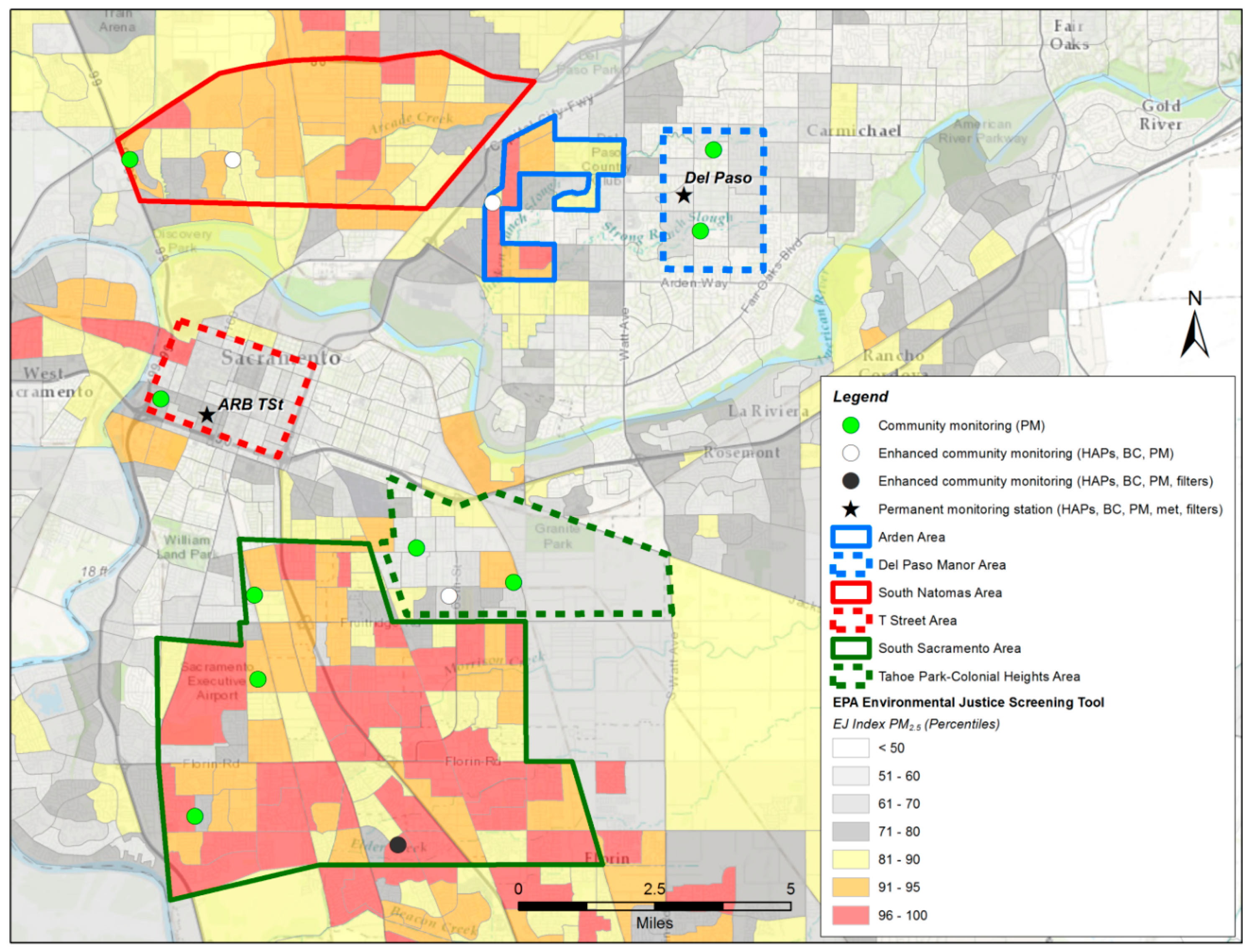
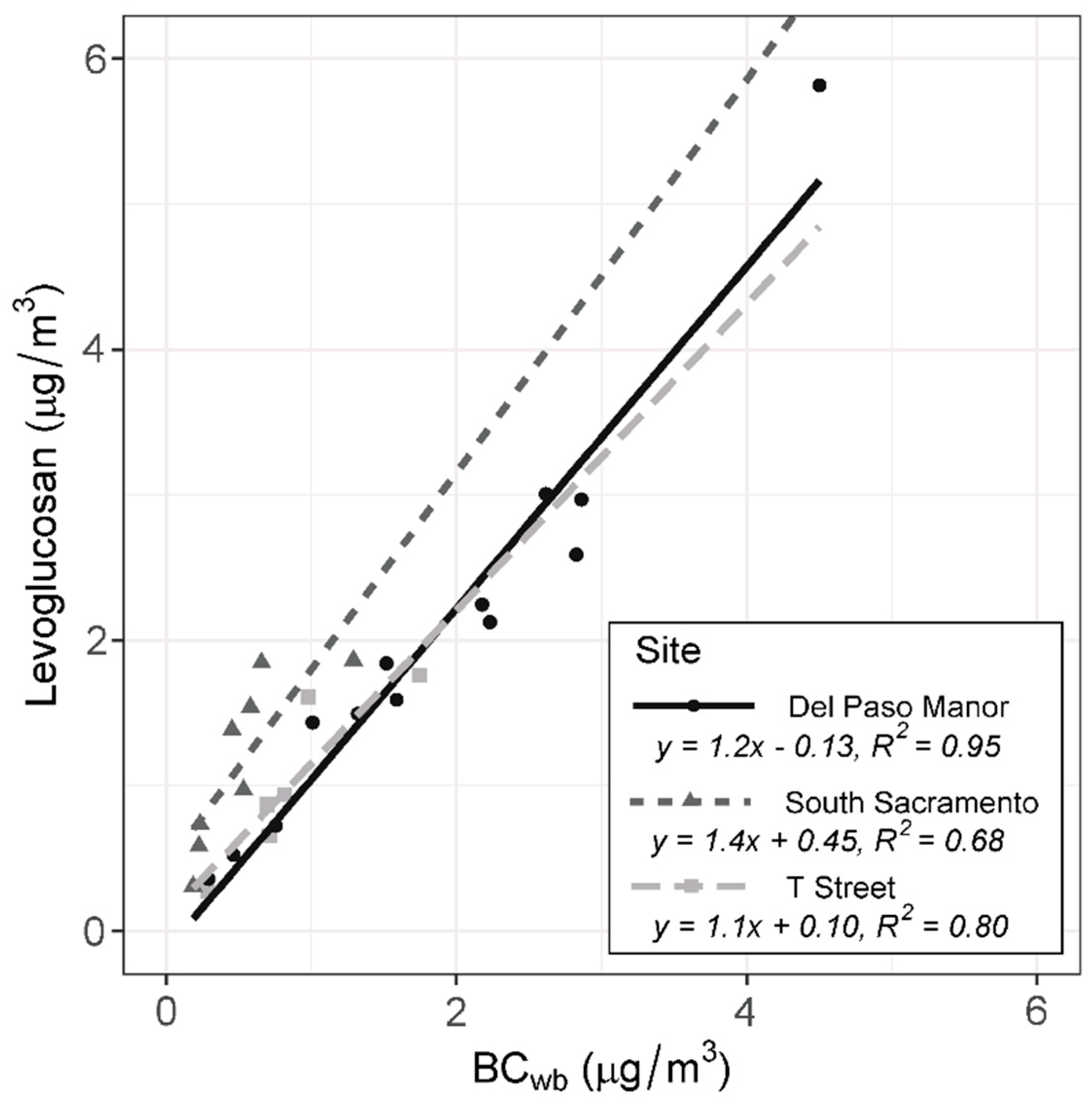
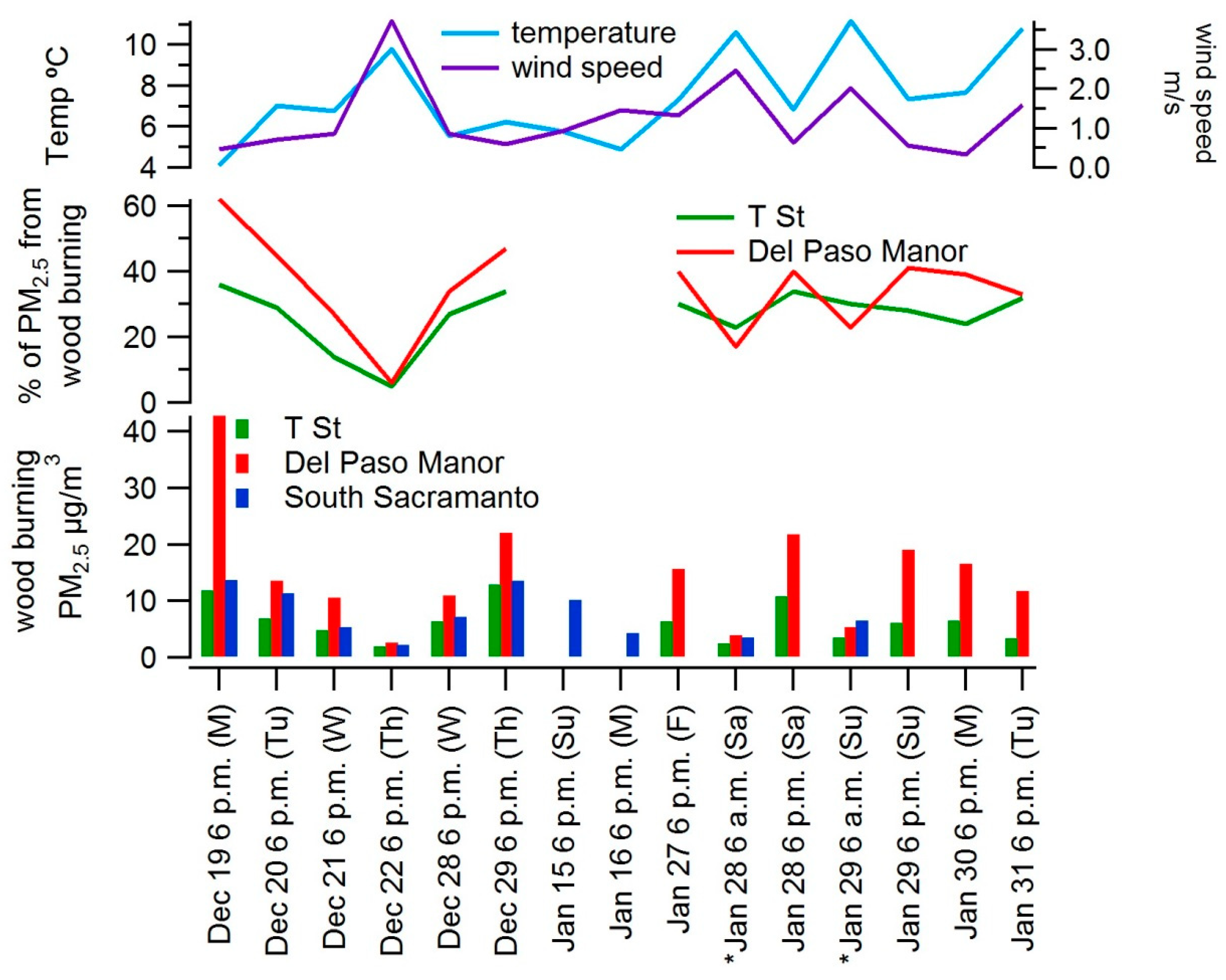

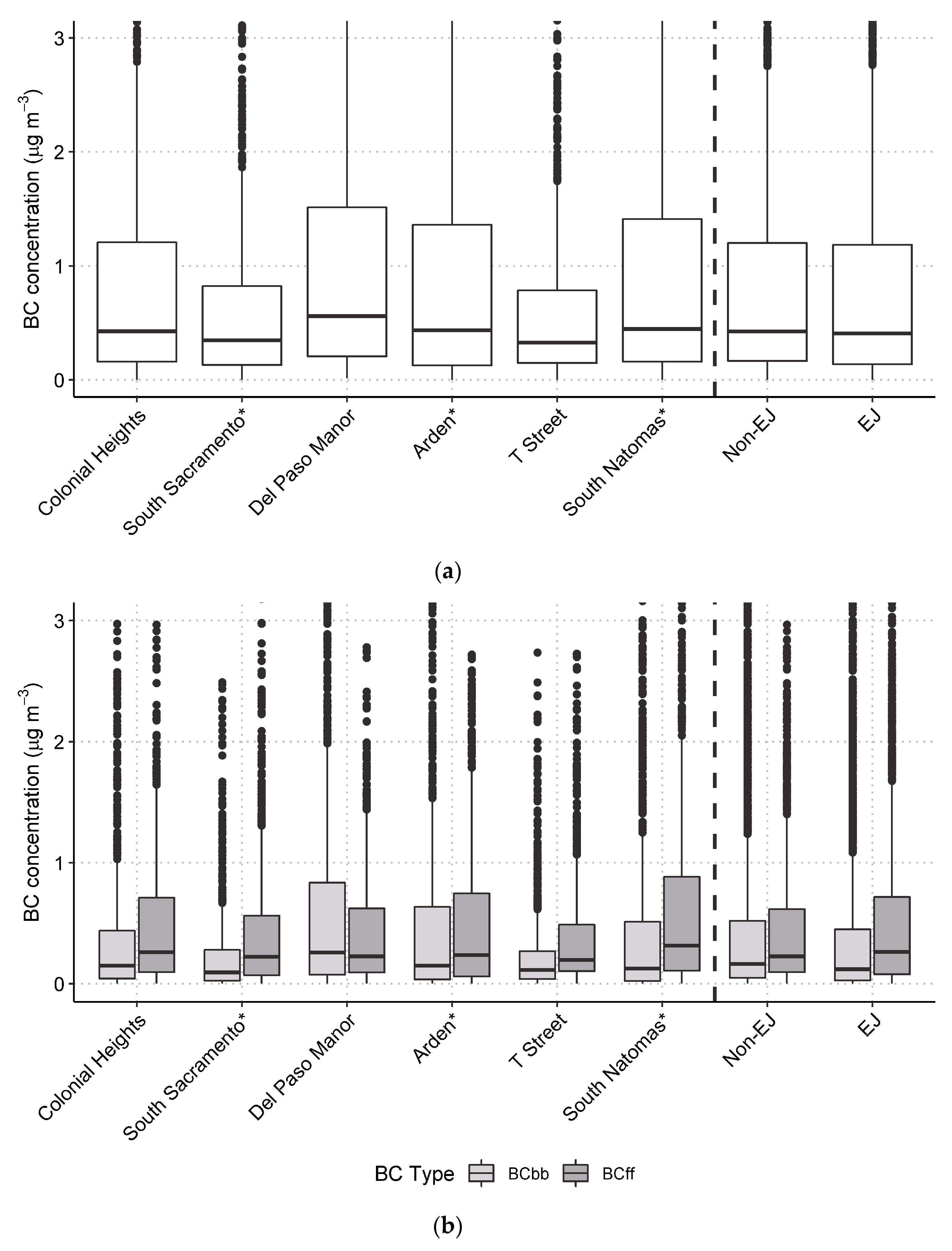
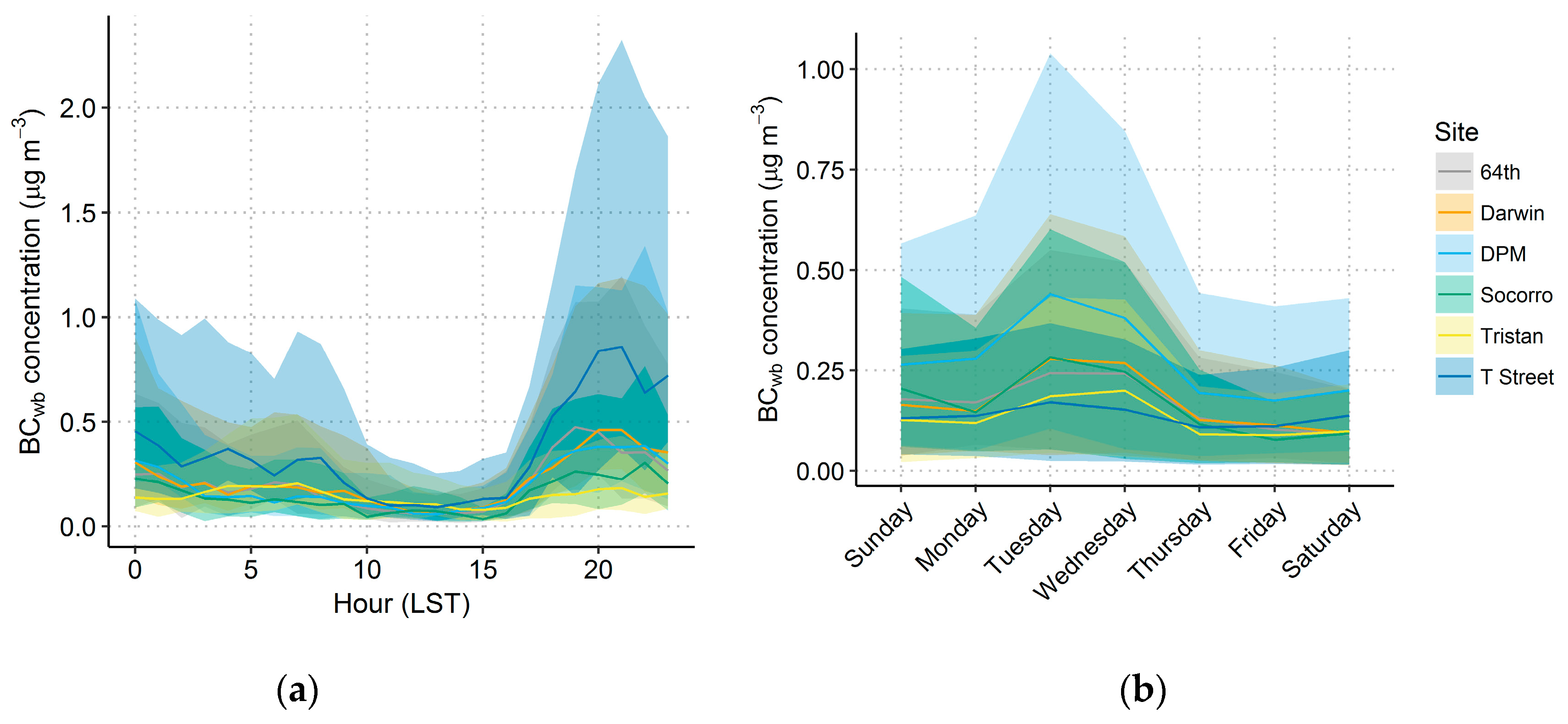
| Pollutant | Method | Resolution | Frequency | Colonial Heights (Non-EJ) | South Sacramento (EJ) | T Street (Non-EJ) | South Natomas (EJ) | Del Paso Manor (Non-EJ) | Arden (EJ) |
|---|---|---|---|---|---|---|---|---|---|
| BC, BCff, BCwb | Aethalometer | Hourly | Continuous | X | X | X | X | X | X |
| PM2.5 | AirBeam sensor | 1 min | Continuous | X | X | X | X | X | X |
| PM2.5 | Met One BAM | Hourly | Continuous | X | X | ||||
| PM2.5 | FRM R&P 2025 | 24 h | Daily | X | X | ||||
| Gaseous HAPs | Canister sample; TO-15 | 12 h | Episodic | X | X | X | X | X | X |
| Levoglucosan, OC, EC | Filter collected with mini-vol or Thermo 2025i filter sampler | 12 h | Episodic, coincident with canister samples | X | X | X | |||
| Wind speed, direction, temperature | R.M. Young company (ultrasonic) | Hourly | Continuous | X | X |
| Analyte | Emissions Sources | N Collocated Samples | Median Precision % | Average Precision % | Average Concentration |
|---|---|---|---|---|---|
| 2,2,4-Trimethylpentane (iso-octane) | Mobile source tracer | 10 | 5.1 | 5.9 | 0.3 |
| Acetylene | Mobile source tracer | 10 | 5.3 | 6.2 | 2.96 |
| Benzene | Air toxic | 10 | 6.3 | 8.5 | 0.62 |
| Carbon Tetrachloride | Air toxic; internal QC | 10 | 5.8 | 8.5 | 0.09 |
| Toluene | Combustion indicator | 10 | 11.0 | 12.6 | 1.9 |
| m- and p-Xylenes | Combustion indicator | 10 | 9.4 | 14.0 | 0.59 |
| Ethylbenzene | Air toxic | 10 | 9.0 | 15.2 | 0.19 |
| Acetonitrile | Air toxic | 10 | 12.7 | 17.2 | 0.14 |
| 1,3-Butadiene | Air toxic | 10 | 12.1 | 18.2 | 0.17 |
| Acrolein | Air toxic | 10 | 40.0 | 46.0 | 0.27 |
| Acrylonitrile | Air toxic | 10 | <MDL | <MDL | <MDL |
| Levoglucosan | Wood burning | 5 | 3.3% | 4.4% | 1.1 |
| Statistic | Del Paso Manor | T Street | South Sacramento |
|---|---|---|---|
| N 12 h samples (N night, day) | 13 (11, 2) | 13 (11, 2) | 10 (8, 2) |
| Median PM2.5 | 39 | 24 | n/a |
| Median levoglucosan | 1.84 | 0.86 | 0.93 |
| Median wood burning PM | 13.5 | 6.3 | 6.8 |
| % PM from wood burning | 39% | 29% | n/a |
| Analyte | MDL | Colonial Heights (Non-EJ) | South Sacramento (EJ) | T Street (Non-EJ) | South Natomas (EJ) | Del Paso Manor (Non-EJ) | Arden (EJ) | All Non-EJ | All EJ | p-Value (Between All Non-EJ and All EJ Sites) |
|---|---|---|---|---|---|---|---|---|---|---|
| 1,3-Butadiene | 0.026 | 0.166 | 0.163 | 0.167 | 0.222 | 0.154 | 0.224 | 0.160 | 0.202 | 0.12 |
| 2,2,4-Trimethylpentane | 0.010 | 0.304 | 0.367 | 0.285 | 0.449 | 0.336 | 0.467 | 0.316 | 0.428 | 0.02 |
| Acetonitrile | 0.051 | 0.127 | 0.121 | 0.153 | 0.161 | 0.146 | 0.140 | 0.141 | 0.141 | 0.33 |
| Acetylene | 0.029 | 3.714 | 3.162 | 2.905 | 2.897 | 2.153 | 3.079 | 2.814 | 3.046 | 0.21 |
| Acrolein | 0.120 | 0.234 | 0.290 | 0.317 | 0.260 | 0.235 | 0.339 | 0.249 | 0.296 | <0.01 |
| Benzene | 0.021 | 0.562 | 0.593 | 0.598 | 0.776 | 0.585 | 0.798 | 0.580 | 0.722 | 0.05 |
| Carbon Tetrachloride | 0.016 | 0.085 | 0.088 | 0.089 | 0.083 | 0.090 | 0.089 | 0.087 | 0.087 | 0.07 |
| Ethylbenzene | 0.019 | 0.176 | 0.243 | 0.209 | 0.244 | 0.154 | 0.259 | 0.171 | 0.230 | 0.02 |
| m- and p-Xylenes | 0.040 | 0.523 | 0.564 | 0.603 | 0.814 | 0.478 | 0.896 | 0.515 | 0.758 | <0.01 |
| Toluene | 0.017 | 0.973 | 1.289 | 1.146 | 1.697 | 0.973 | 1.648 | 1.004 | 1.544 | <0.01 |
| Parameters | Acetonitrile | Acetylene | Acrolein | BC | BCff | BCwb | Benzene | CCl4 | Ethylbenzene | m,p-Xylene | Toluene | 1,3-Butadiene | iso-octane | Levoglucosan |
|---|---|---|---|---|---|---|---|---|---|---|---|---|---|---|
| Acetonitrile | N/A | 0.17 | 0.03 | 0.10 | 0.09 | 0.07 | 0.47 | 0.01 | 0.36 | 0.33 | 0.35 | 0.37 | 0.36 | 0.21 |
| Acetylene | 0.17 | N/A | 0.00 | 0.11 | 0.05 | 0.12 | 0.53 | 0.12 | 0.46 | 0.43 | 0.43 | 0.54 | 0.43 | 0.07 |
| Acrolein | 0.03 | 0.00 | N/A | 0.07 | 0.05 | 0.06 | 0.02 | 0.06 | 0.00 | 0.00 | 0.00 | 0.02 | 0.00 | 0.11 |
| BC | 0.10 | 0.11 | 0.07 | N/A | 0.71 | 0.84 | 0.10 | 0.00 | 0.10 | 0.08 | 0.09 | 0.08 | 0.11 | 0.85 |
| BCff | 0.09 | 0.05 | 0.05 | 0.71 | N/A | 0.31 | 0.06 | 0.01 | 0.04 | 0.03 | 0.03 | 0.06 | 0.05 | 0.05 |
| BCwb | 0.07 | 0.12 | 0.06 | 0.84 | 0.31 | N/A | 0.09 | 0.00 | 0.11 | 0.09 | 0.10 | 0.06 | 0.11 | 0.88 |
| Benzene | 0.47 | 0.53 | 0.02 | 0.10 | 0.06 | 0.09 | N/A | 0.03 | 0.80 | 0.78 | 0.84 | 0.87 | 0.78 | 0.17 |
| CCl4 | 0.01 | 0.12 | 0.06 | 0.00 | 0.01 | 0.00 | 0.03 | N/A | 0.06 | 0.06 | 0.06 | 0.08 | 0.07 | 0.00 |
| Ethylbenzene | 0.36 | 0.46 | 0.00 | 0.10 | 0.04 | 0.11 | 0.80 | 0.06 | N/A | 0.97 | 0.90 | 0.67 | 0.90 | 0.15 |
| m- and p-Xylene | 0.33 | 0.43 | 0.00 | 0.08 | 0.03 | 0.09 | 0.78 | 0.06 | 0.97 | N/A | 0.85 | 0.68 | 0.85 | 0.13 |
| Toluene | 0.35 | 0.43 | 0.00 | 0.09 | 0.03 | 0.10 | 0.84 | 0.06 | 0.90 | 0.85 | N/A | 0.72 | 0.91 | 0.17 |
| 1,3-Butadiene | 0.37 | 0.54 | 0.02 | 0.08 | 0.06 | 0.06 | 0.87 | 0.08 | 0.67 | 0.68 | 0.72 | N/A | 0.65 | 0.11 |
| iso-octane | 0.36 | 0.43 | 0.00 | 0.11 | 0.05 | 0.11 | 0.78 | 0.07 | 0.90 | 0.85 | 0.91 | 0.65 | N/A | 0.16 |
| Levoglucosan | 0.21 | 0.07 | 0.11 | 0.85 | 0.05 | 0.88 | 0.17 | 0.00 | 0.15 | 0.13 | 0.17 | 0.11 | 0.16 | N/A |
| Metric | EJ | Non-EJ |
|---|---|---|
| Fraction of homes with fireplace (question S3) | 80 | 79 |
| Fraction of homes with any indoor device (question S3) | 91 | 89 |
| Fraction of homes with wood or pellet stove (question S3) | 7 | 8 |
| Fraction of homes with only outdoor burning (question S3) | 7 | 5 |
| Fraction of homes with outdoor and indoor burning (question S3) | 92 | 91 |
| Relative burn days with indoor fireplace (question S3 × 4.0a; × 4.1a) | 0.27 | 0.43 |
| Relative burn days with wood or pellet stove (question S3 × 4.2a) | 0.48 | 0.7 |
| Relative burn days with any indoor device (question S3 × 4.0,4.1,4.2) | 0.31 | 0.48 |
| Of households that burn, fraction of homes burning at night with indoor fireplace (question 4.0b) | 67 | 79 |
| Of households that burn, fraction of homes burning day with indoor fireplace (question 4.0b) | 10 | 9 |
| Of households that burn, fraction of homes burning day and night with indoor fireplace (question 4.0b) | 19 | 9 |
| Of households that burn, fraction of homes burning at night with fireplace (question S3 × 4.0b) | 76 | 57 |
| Of households that burn, fraction of homes burning at night with wood or pellet stove (question S3 × 4.0b) | n/a | n/a |
| Fraction of homes burning with certified device (question 4.0c) | 34 | 28 |
| Fraction of homes burning indoor fireplace (questions 5.2 and 5.4) | 28 | 38 |
| Fraction of homes burning on “Check Before You Burn” days (question 5.2 and 5.4) | 46 | 47 |
| 1,3-Butadiene μg/m3 | 0.18 | 0.16 |
| 2,2,4-Trimethylpentane μg/m3 | 0.37 | 0.31 |
| Acetonitrile μg/m3 | 0.14 | 0.14 |
| Acetylene μg/m3 | 2.99 | 2.92 |
| Acrolein μg/m3 | 0.27 | 0.26 |
| Benzene μg/m3 | 0.65 | 0.58 |
| Carbon Tetrachloride μg/m3 | 0.09 | 0.09 |
| Ethylbenzene μg/m3 | 0.20 | 0.18 |
| m- and p-Xylenes μg/m3 | 0.64 | 0.53 |
| Toluene μg/m3 | 1.34 | 1.03 |
| BCwb μg/m3 | 0.41 | 0.48 |
© 2020 by the authors. Licensee MDPI, Basel, Switzerland. This article is an open access article distributed under the terms and conditions of the Creative Commons Attribution (CC BY) license (http://creativecommons.org/licenses/by/4.0/).
Share and Cite
Brown, S.G.; Lam Snyder, J.; McCarthy, M.C.; Pavlovic, N.R.; D’Andrea, S.; Hanson, J.; Sullivan, A.P.; Hafner, H.R. Assessment of Ambient Air Toxics and Wood Smoke Pollution among Communities in Sacramento County. Int. J. Environ. Res. Public Health 2020, 17, 1080. https://doi.org/10.3390/ijerph17031080
Brown SG, Lam Snyder J, McCarthy MC, Pavlovic NR, D’Andrea S, Hanson J, Sullivan AP, Hafner HR. Assessment of Ambient Air Toxics and Wood Smoke Pollution among Communities in Sacramento County. International Journal of Environmental Research and Public Health. 2020; 17(3):1080. https://doi.org/10.3390/ijerph17031080
Chicago/Turabian StyleBrown, Steven G., Janice Lam Snyder, Michael C. McCarthy, Nathan R. Pavlovic, Stephen D’Andrea, Joseph Hanson, Amy P. Sullivan, and Hilary R. Hafner. 2020. "Assessment of Ambient Air Toxics and Wood Smoke Pollution among Communities in Sacramento County" International Journal of Environmental Research and Public Health 17, no. 3: 1080. https://doi.org/10.3390/ijerph17031080
APA StyleBrown, S. G., Lam Snyder, J., McCarthy, M. C., Pavlovic, N. R., D’Andrea, S., Hanson, J., Sullivan, A. P., & Hafner, H. R. (2020). Assessment of Ambient Air Toxics and Wood Smoke Pollution among Communities in Sacramento County. International Journal of Environmental Research and Public Health, 17(3), 1080. https://doi.org/10.3390/ijerph17031080





